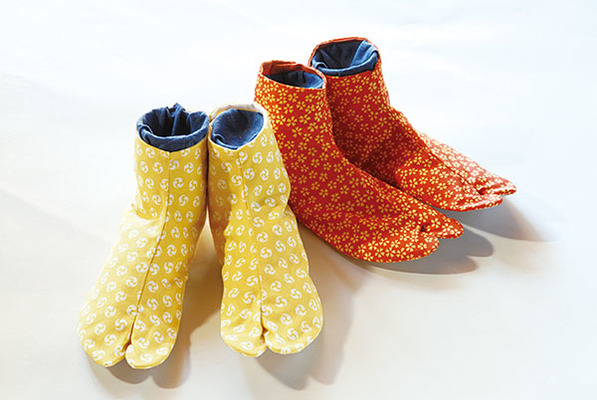
- Other textiles
- Saitama
Gyoda Tabi Socks Gyoda tabi
An item essential when wearing a kimono
made in a major production area of cotton
Description
What is Gyoda Tabi Socks ?
Gyoda Tabi Socks, known as Gyoda Tabi in Japanese, are produced in Gyoda, Saitama Prefecture, which is the largest production center of tabi socks in Japan. Gyoda is surrounded by two large rivers, Tonegawa River and Arakawa River, and has an abundant supply of water and sandy soil. This environment and the perfect climate where it becomes very hot in the summer, was perfect for growing cotton, and made Gyoda the production center of cotton. Additional to this, as it was close to Nakasendo, one of the five major roads that lead to Edo (current Tokyo) in the Edo period, production of tabi socks thrived. The socks are made of cotton and the hooks to fasten the socks are made of brass, aluminum or something similar. The socks are sewn three dimensionally so that the toes fit well. Even today, they are an essential item for the Japanese kimono culture.
History

There are three tabi shops in the map of the town of Gyoda called Gyoda machiezu drawn between 1716-1735, meaning that the production of Gyoda Tabi started around this time. Around 1830-1844, the number of tabi shops increased to twenty seven. The demand for tabi increased as they became widely used by the public, and the Gyoda Tabi merchants expanded their sales channels to the northeast region and Hokkaido. With the increase of production, their production process developed too, and they started to use a special sewing machine made especially for sewing tabi socks. The economic boom due to the Russo-Japanese War (1904-1905) also boosted the construction of tabi factories. With the increase of tabi production, tabi warehouses to store the products also increased, and about eighty warehouses still exist today. The sight of these warehouses makes the town of Gyoda look elegant and classical. When the production of tabi socks were at its peak in 1938-1939, approximately 80 percent of tabi socks produced in Japan were made in Gyoda, and the town was called "The Number One Town of Tabi in Japan". Although most people wear socks today, tabi socks are still produced in Gyoda, and they continue to present new products within Japan and overseas.
General Production Process

- 1. Preparation for cutting
Ten sheets of fabric are placed one on top of the other and are prepared to be cut.
- 2. Cutting
The tabi pattern is placed and the fabric is cut.
- 3. Attaching thread loops
The thread loops where the hooks fit when fastening the socks are attached.
- 4. Securing the thread loops
The thread loops are firmly fixed so that they don't move.
- 5. Fabric backing
A fabric is sewn on the back where the hook is attached.
- 6. Attaching the hooks
The hooks are sewn on.
- 7. Sewing the inner and outer fabrics
The inner and outer fabrics are sewn together.
- 8. Sewing the instep
The instep part of the tabi is sewn.
- 9. Sewing the heel
The heel part is sewn roundly.
- 10. Sewing the toe part
The sole cloth is attached and the toe part is sewn.
- 11. Sewing the sole cloth
The parts other than the toes are sewn to attach the sole cloth.
- 12. Zigzag stitching
Zigzag stitching is applied where the sole cloth has been sewn on to prevent fraying.
- 13. Finishing
The shape of the tabi is adjusted and the tabi is complete.
Where to Buy & More Information
Gyoda City Folk Museum
-
Address
-
ClosedClosed on Mondays (open on holidays), day after holiday (open on Saturdays and Sundays), every fourth Friday (open when an exhibition is being held), year end and New year holidays, and other temporarily closed days
-
Business Hours9am to 4:30pm
-
AccessTransportation: Take the Asahi Bus from JR Fukiage Station (North gate) and get off at "Oshijo" or, Take the City Circular bus (East course) from JR Gyoda Station 【Clockwise course】Get off at "Oshijo / Kyodo Hakubutsukan Mae" 【Counter-clockwise course】Get off at "Gyoda-shi Bus Terminal", 5 minute walk from the bus stop
-
Website































































































































































































































































































